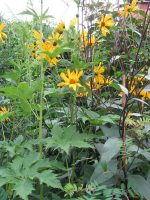 This herbaceous perennial, also known as Appalachian sunflower and hair wood sunflower, is native to southeastern US where it grows in woodlands and disturbed areas such as meadow, fields and roadways. It is a member of the aster family, Asteraceae, that also includes daisy, yarrow, and lettuce. Plants grow 3-5′ tall and have stems that are hairy in the lower half and carry mostly basal leaves that are lanceolate to ovate, hairy and rough on top, and have crenate or serrate margins and winged petioles. From mid to late summer plants produce 1-15 flowerheads that are up to 2″ wide and have 10-15 yellow ray flowers surrounding a center of 75 or more red or purple disc flowers. The flowers are attractive to bees and butterflies and the seeds are eaten by songbirds, ruffed grouse, quail, morning doves, and small mammals. Purple disc sunflower is an excellent choice for a wildlife, butterfly, native plant, cottage, or woodland garden. The genus name, Helianthus, comes from the Greek words helios, meaning sun, and anthos meaning flower and and may refer to the resemblance of the flowerhead to the sun. The specific epithet, atrorubens, comes from the Latin words ater meaning black and ruber meaning red, and refers to the color of the disc flowers.
This herbaceous perennial, also known as Appalachian sunflower and hair wood sunflower, is native to southeastern US where it grows in woodlands and disturbed areas such as meadow, fields and roadways. It is a member of the aster family, Asteraceae, that also includes daisy, yarrow, and lettuce. Plants grow 3-5′ tall and have stems that are hairy in the lower half and carry mostly basal leaves that are lanceolate to ovate, hairy and rough on top, and have crenate or serrate margins and winged petioles. From mid to late summer plants produce 1-15 flowerheads that are up to 2″ wide and have 10-15 yellow ray flowers surrounding a center of 75 or more red or purple disc flowers. The flowers are attractive to bees and butterflies and the seeds are eaten by songbirds, ruffed grouse, quail, morning doves, and small mammals. Purple disc sunflower is an excellent choice for a wildlife, butterfly, native plant, cottage, or woodland garden. The genus name, Helianthus, comes from the Greek words helios, meaning sun, and anthos meaning flower and and may refer to the resemblance of the flowerhead to the sun. The specific epithet, atrorubens, comes from the Latin words ater meaning black and ruber meaning red, and refers to the color of the disc flowers.
Type: Herbaceous perennial
Bloom: Two inch wide flowerheads composed of yellow ray flowers around a center of red or purple disc flowers from mid summer to late fall
Size: 3-5′ H x 1-3′ W
Light: Full sun to partial shade
Soil: Average, moderately moist, well-drained
Hardiness: Zones 6-8
Care: Low maintenance
Pests and Diseases: Downy mildew
Propagation: Seed, stem cuttings
Companion Plants: Aster, goldenrod, coral bells
Photo Credit: Wikipedia